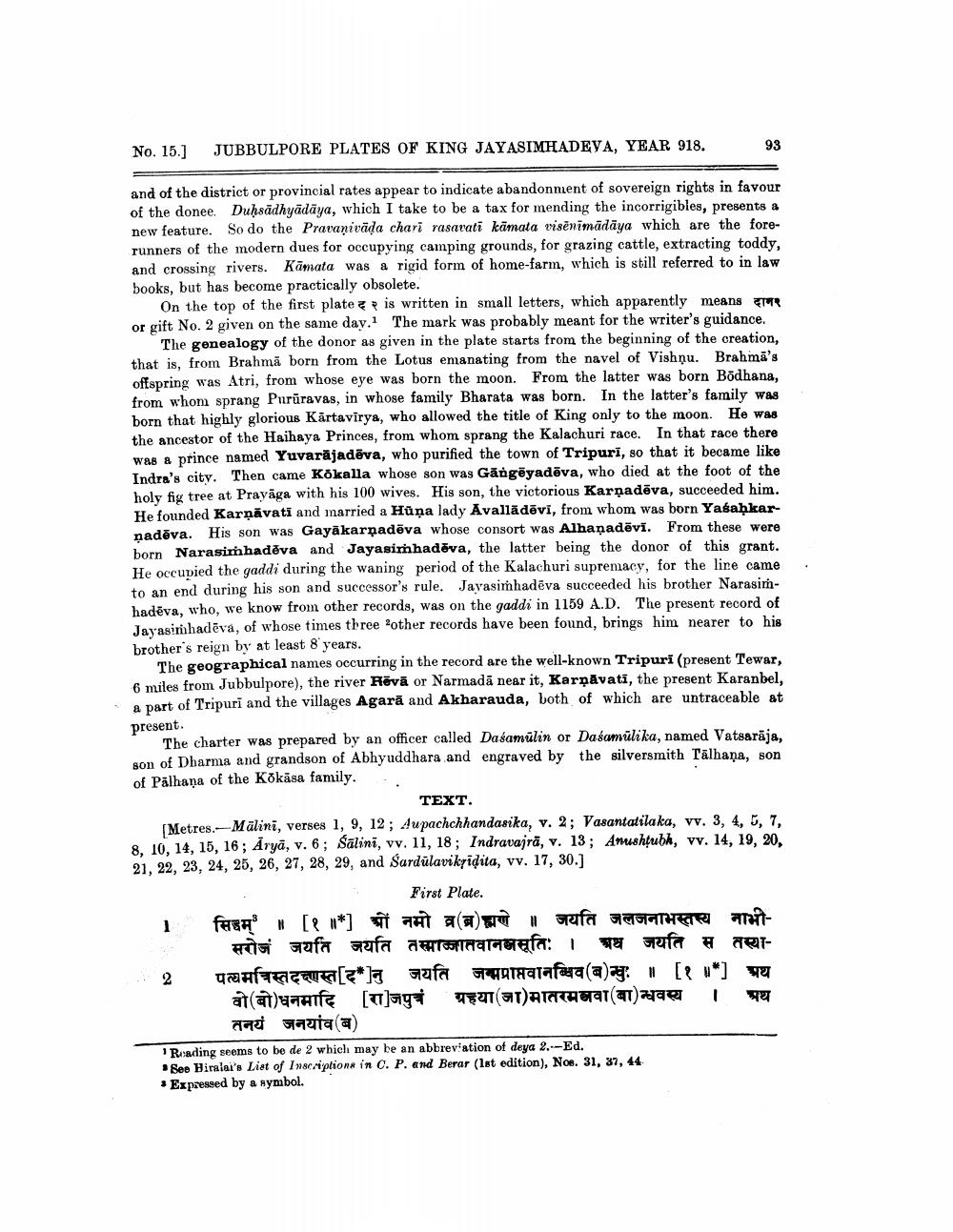________________
No. 15.]
JUBBULPORE PLATES OF KING JAYASIMHADEVA, YEAR 918.
93
and of the district or provincial rates appear to indicate abandonment of sovereign rights in favour of the donee. Duhsādhyādāya, which I take to be a tax for mending the incorrigibles, presents & new feature. So do the Pravanivāda chari rasarati kāmata visēnīmādāya which are the forerunners of the modern dues for occupying camping grounds, for grazing cattle, extracting toddy, and crossing rivers. Kāmata was a rigid form of home-farm, which is still referred to in law books, but has become practically obsolete.
On the top of the first plate is written in small letters, which apparently means TR or gift No. 2 given on the same day. The mark was probably meant for the writer's guidance.
The genealogy of the donor as given in the plate starts from the beginning of the creation, that is, from Brahmă born from the Lotus emanating from the navel of Vishnu. Brahma's offspring was Atri, from whose eye was born the moon. From the latter was born Bödhana, from whom sprang Purūravas, in whose family Bharata was born. In the latter's family was born that highly glorious Kārtavirya, who allowed the title of King only to the moon. He was the ancestor of the Haihaya Princes, from whom sprang the Kalachuri race. In that race there was a prince named Yuvarājadēva, who purified the town of Tripurī, so that it became like Indra's city. Then came Kokalla whose son was Găngeyadēva, who died at the foot of the holy fig tree at Prayaga with his 100 wives. His son, the victorious Karnadēva, succeeded him. He founded Karnävati and married a Hūņa lady Avallādēvi, from whom was born Yaśaḥkarnadēva. His son was Gayākarpadēva whose consort was Albanadēvi. From these were born Narasimhadēva and Jayasimhadova, the latter being the donor of this grant. He occupied the gaddi during the waning period of the Kalachuri supremacy, for the lire came to an end during his son and successor's rule. Jayasimhadēva succeeded his brother Narasimhadēva, who, we know from other records, was on the gaddi in 1159 A.D. The present record of Jayasinhadeva, of whose times three other records have been found, brings him nearer to his brother's reign by at least 8 years.
The geographical names occurring in the record are the well-known Tripuri (present Tewar, 6 miles from Jubbulpore), the river Hēvā or Narmadā near it, Karnavati, the present Karanbel, a part of Tripuri and the villages Agarā and Akharauda, both of which are untraceable at present.
The charter was prepared by an officer called Dasamulin or Dasamülika, named Vatsarāja, son of Dharma and grandson of Abhyuddhara and engraved by the silversmith Tālhaņa, son of Palhana of the Kökāsa family.
TEXT. Metres.- Mālini, verses 1, 9, 12, Aupachchhandasika, v. 2; Vasantatilaka, vv. 3, 4, 5, 7, 8. 10, 14, 15, 16; Aryā, v. 6; Salini, vv. 11, 18; Indravajrā, v. 13; Amushţubh, vv. 14, 19, 20, 21, 22, 23, 24, 25, 26, 27, 28, 29, and Sardūlavikyidita, vv. 17, 30.]
First Plate. 1 fasư | [ *] [ Bát (I) | safe west Had -
सरोज जयति जयति तस्माज्जातवानमसूतिः । अथ जयति स तस्याgan Tica[z*l gafa tarafara(a)ag: [ #] Yu
वो(बो)धनमादि [राजपुत्र ग्रहया(जा)मातरमनवा(बान्धवस्य । अथ तनयं जनयांव(ब)
Reading seems to be de 2 which may be an abbreviation of deya 2.--Ed. See Hiralai's List of Inscriptions in C. P. and Berar (1st edition), Noe. 31, 37, 44 • Expressed by a symbol.




